Gaia
See just this Post & Comments / 0 Comments so far / Post a Comment / HomeSaturday, April 8, 2006
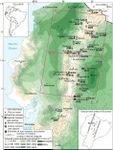 Felicia Mello and Pauline Bartolone in Salon:
Felicia Mello and Pauline Bartolone in Salon:The heat on Ecuador. (Archive), discussion.
When the water runs out. (Archive), discussion.
Friday, March 31, 2006
Two articles from Der Spiegel on political and entrepreneurial responses:
Spiegel: Climate Change Sparks Scrap for Arctic Resources (Archive), discussion.
Spiegel: Profiteering from the Arctic Thaw (Archive), discussion.
Saturday, March 25, 2006
Lake Dal in the city of Srinagar, India; you can find Srinagar on the first map up to the top left, and see the lake in the townsite in the other three:
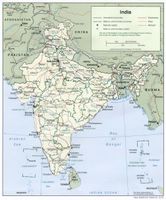
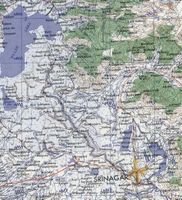
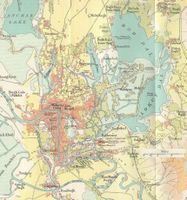
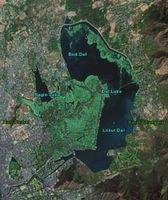
What caught me here was the first news photo (below), by Tauseef Mustafa; the caption read in part "Indian Kashmir is stepping up efforts to save its watery jewel ringed by Himalayan peaks from pollution that threatens to turn it into a weed-clogged swamp just as tourists return to the revolt-hit region." Not just revolts either, you may notice that Srinagar is not far from Muzaffarabad which is between the 'bordere' and the 'line of control', truly no-man's land, where some of the camps for earthquake survivors are set up.
The notion of "build it and they will come" gets at most an ironic and sarcastic grunt from cynical boomers, so it goes. For me, old hippie that I am, the reason to clean something up is because it is dirty, because you respect some part of it at some level and want to restore it to itself. I bet my friend Crowbird is still driving around B.C. picking up garbage, which is where I met him in '73 or so - picking up garbage left behind by a fair, after all of the 'organizers' had left. This was the last Festival of the Sun on the property of my friend Simon Charlie, and I fell in with Crowbird, cleaning up, trying to give something back to Simon that really meant something. You may snort at such youthful idealism, nonetheless, I must have done something right because just a few days before he died I did so happen to be there again and said a prayer for Simon. That feels like a great gift to me. I built a house there which is still standing - the only tangible evidence of my career as an architect.
So when I thought that (according to a tiny bit of text attached to one photograph out of thousands - I know it is not necessarily true, ok?) they wanted to restore this jewel simply for the tourists, well ... I thought that maybe there was a better reason. No problem if they fix it for the wrong reason (nevermind T.S. Eliot and his "it is the greatest treason, to do the right deed for the wrong reason"), at least it will be fixed. Just rambling ... No idea who the fellow in the boat collecting samples is but I like the look of him. I would like to think that he is the same guy who will look at the samples closely, recognize them, begin to formulate a clever strategy with tactics to restore balance that do not involve any cousins of Agent Orange.





The last photograph, by Fayaz Kabli, sums it up for me; the obvious culprits, sewage, garbage, greed, unthinking exploitation, 'development', what ever. Someone actually said that to me one time - an alderman for the town I lived in, Metcalfe, just south of Ottawa, member of my church even. They were paving the gravel road that went past my farm - it was just a scam to give money to the guys who ran the gravel pit and happened to have a kiln for making hot-mix. He said to me, "Well, you can't stand in the way of progress." I would have, but I had other dragons to fight at the time. I liked the gravel, you could hear the cars coming and I wasn't so much afraid for the kids playing in the yard.
Wednesday, March 22, 2006
Interesting article in Spiegel this morning - Sweden is moving to get off oil and onto wood chips. On a direct CO2 basis considering just cars it is probably a dead heat, but considering that new forests take up CO2 there might be a net benefit globally. Spiegel: Sweden Plans Wood-fueled Future (Archive), discussion.
Seems to me I remember the Nazis doing something like that at the end of the war - powering VW Beetles with trailers of wood chips ... let's see if I can find a picture ... Yes, there is quite a widespread notion that these were powered by steam, nonsense of course, goes to show you about the Internet, one idiot makes a statement and ten dozen copy it. Steam is sometimes involved, but to reduce the 'wood gas' to hydrogen. The principle of the gas generator is simple: shutting out oxygen, one heats wood to a temperature of about 700 to 800 degrees Celsius. Wood gas is the result, a mixture whose main components are carbon dioxide, carbon monoxide, methane, ethane, hydrogen and water vapor.
I remember seeing a picture of one with a trailer to carry the wood chips, or maybe the gasifier too, but I cant find it. The technical description appears to have been T230 and the model names Holzbrenner, Kubelwagen, KdF Wagens, Type 60, Type 82 ... who knows what else ... well, it appears that 'wood gas' was quite widely used during the war, not only by VW, check this out, from FEMA no less: Executive summary and complete instructions on how to build one. All sorts of things out there (images have source urls embedded in the Author Property):









Sunday, March 19, 2006
 Well ... I guess I was right the first time, this Lovelock guy IS a flake. Three of his books later: Gaia, A New Look at Life on Earth; The Ages of Gaia; and The Revenge of Gaia ... teleological arguments must be couched in biblical language if they are going to wash, and Jimmy Lovelock cannot come up with it. Too bad.
Well ... I guess I was right the first time, this Lovelock guy IS a flake. Three of his books later: Gaia, A New Look at Life on Earth; The Ages of Gaia; and The Revenge of Gaia ... teleological arguments must be couched in biblical language if they are going to wash, and Jimmy Lovelock cannot come up with it. Too bad.He is right of course.
Tim Flannery's The Weather Makers on the other hand does wash (if you will pardon the twisted hand metaphors) and makes the point for both of them.
20,000 Leagues Under the Sea - anyone know where can I buy a good used submarine?
He tells us that there was a time, 8,000 years ago or so when the human population was reduced to about 2,000 - and we scraped through that time. How to arrange to be among the blood lines represented this time I wonder? (Since I really am too old, probably will not make it to a front-row seat for the main event.) Now THAT might redeem me in the eyes of my great-grandchildren eh?
He also repeated a notion that I picked up from On The Beach by Nevil Shute - that there is minimal exchange in the atmosphere between the north and south hemispheres.
God Knows, Bob Dylan, 1990
God knows you ain't pretty,
God knows it's true.
God knows there ain't anybody
Ever gonna take the place of you.
God knows it's a struggle,
God knows it's a crime,
God knows there's gonna be no more water
But fire next time.
God didn't call it treason,
God didn't call it wrong,
It was supposed to last a season
But it's been so strong for so long.
God knows it's fragile,
God knows everything,
God knows it could snap apart right now
Just like putting scissors to a string.
God knows it's terrifying,
God sees it all unfold,
There's a million reasons for you to be crying
You been so bold and so cold.
God knows that when you see it,
God knows you've got to weep,
God knows the secrets of your heart,
He'll tell them to you when you're asleep.
God knows there's a river,
God knows how to make it flow,
God knows you ain't gonna be taking
Nothing with you when you go.
God knows there's a purpose,
God knows there's a chance,
God knows you can rise above the darkest hour
Of any circumstance.
God knows there's a heaven,
God knows it's out of sight,
God knows we can get all the way from here to there
Even if we've got to walk a million miles by candlelight.
Tuesday, March 14, 2006
 Got a copy of Lovelock's book, The Revenge of Gaia, yesterday, had to order it from England - now I am having a read of it. Unfortunately he begins with images of the Tsunami in Indonesia last year. This was the same mistake that Presidente Lula made in a speech somewhere, but I would hardly expect it from the guy who invented the concept - earthquakes and such simply are not effects of global warming. It is hard to read the book unless you are already a convert. Meanwhile (in)credible demonstrations from Greenpeace and Friends of the Earth, with kites and banners, blow-up dinosaurs and the like ...
Got a copy of Lovelock's book, The Revenge of Gaia, yesterday, had to order it from England - now I am having a read of it. Unfortunately he begins with images of the Tsunami in Indonesia last year. This was the same mistake that Presidente Lula made in a speech somewhere, but I would hardly expect it from the guy who invented the concept - earthquakes and such simply are not effects of global warming. It is hard to read the book unless you are already a convert. Meanwhile (in)credible demonstrations from Greenpeace and Friends of the Earth, with kites and banners, blow-up dinosaurs and the like ...




They are right of course, but they cannot be believed; it becomes just one more idealogy. Keep yourself entertained and wait for Armageddon? - I guess so. I saw the Greenpeace ship Rainbow Warrior one time in Ocean Falls. They came in to get fresh water. Some of the local rednecks didn't want to give it to them but I was in charge of the wharf in those days and I wanted a closer look. There were lots of young nubiles on board, I'll give them that much; Beauties! And looked straight at you when they spoke. Lovelock says this interest in women is residual hunter/gatherer tribalism, probably is.
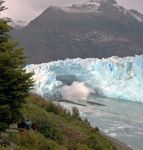 Rupture of the leading edge of the Perito Moreno glacier as the waters of Lake Argentino open a tunnel in the glacier, widening it until its collapse in a massive explosion of ice fragments and water, near the city of El Calafate in the Patagonian privince of Santa Cruz, southern Argentina. The Perito Moreno glacier, part of the Los Glaciares National Park, a World Heritage site, is unusual in that it is still growing forward at the accelerated rate of between 30 and 60 cm per day.
Rupture of the leading edge of the Perito Moreno glacier as the waters of Lake Argentino open a tunnel in the glacier, widening it until its collapse in a massive explosion of ice fragments and water, near the city of El Calafate in the Patagonian privince of Santa Cruz, southern Argentina. The Perito Moreno glacier, part of the Los Glaciares National Park, a World Heritage site, is unusual in that it is still growing forward at the accelerated rate of between 30 and 60 cm per day.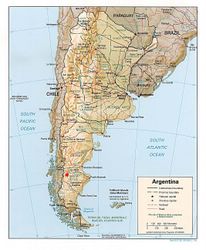
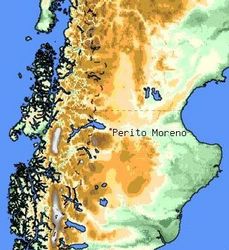
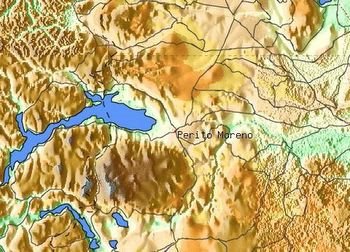
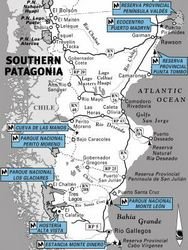
Friday, March 3, 2006
Spiegel: The Ice Is Melting Incredibly Fast (Archive), discussion.
The North-East passage from the eastern Pacific to the western Atlantic is simply half the length of the route through the Suez canal. The North-West passage (from the western Atlantic to the eastern Pacific) is opening up as well - similarly shorter than the route through the Panama canal. Nevermind the huge ecological implications; when the passage on Canada's northern shore is open, the Canadians will have to use a firm hand if they are to maintain sovereignty.
The interview above, with German explorer Arved Fuchs and the photos below tell the story - even granting that the final September image is at the end of the summer, and the January images are in the middle of the winter.

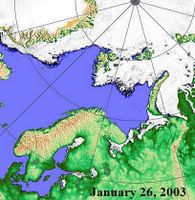
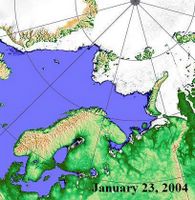
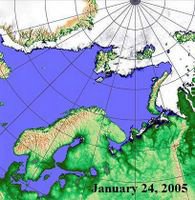
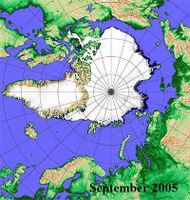
Thursday, March 2, 2006
International Lake Environment Committee, have a Database of Lakes with basic metrics and more.
Thursday, February 23, 2006
Concern about water is so central to my thinking that I am drawn to stories of water in jeopardy like some Internet denizens are drawn to pornography. The notions are not entirely separate. In both a literal and a mythic sense, water figures in our sexuality. Iemanjá is a sexy goddess, and a goddess of the sea. It is not accidental that the Holy Grail is a cup, to drink out of (as it were), and there is a considerable sexual content in Wolfram von Eschenbach's story of Parsifal's quest to find it. The powerful and evocative imagery of Eliot's Waste Land is much about the absence of water. My previous posts on the Amazon came straight from the strong feelings I had when I caught sight of photographs of the 2005 drought.
This post (so far) comes mostly from the English version of Der Spiegel. A note on such outrageous plagiarism is in order. First, the article will stay on their site for a while and then disappear. Second, the accompanying photographs are excellent, but on the Spiegel site they are set up in a way that makes them difficult to compare, and difficult to place exactly in their African context. This link below goes to my copy of their material - and the link on that copy will take you to the original. There is more that could be said about this but that is enough for now.
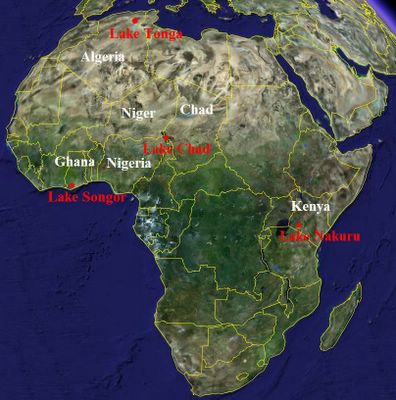 Trying to quickly get reference images from Google Earth for lakes in Africa is an enlightening experience - Lake Chad, Africa [Go] takes you to somewhere in Illinois! Chad, Africa takes you to just west of London England! Useless self-centred twits! And just to add a few bits of text has taken me nearly an hour! AND the red text has bled all over the place - JUNK!! Anyway, it is legible on this screen, barely, but it will have to do for now.
Trying to quickly get reference images from Google Earth for lakes in Africa is an enlightening experience - Lake Chad, Africa [Go] takes you to somewhere in Illinois! Chad, Africa takes you to just west of London England! Useless self-centred twits! And just to add a few bits of text has taken me nearly an hour! AND the red text has bled all over the place - JUNK!! Anyway, it is legible on this screen, barely, but it will have to do for now.Yes, and I got Lake Songor wrong - it is on the other side of Ghana ... oh well, live and learn.
Spiegel: Water Scarcity As Africa's Lakes Shrink (Archive), discussion.
Lake Chad:
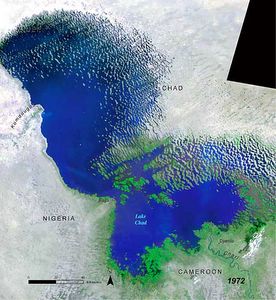
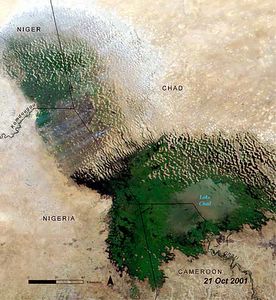
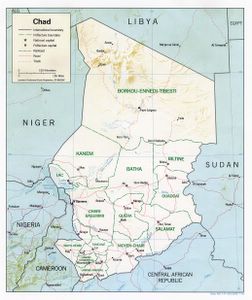
Located at the junction of Nigeria, Niger, Chad, and Cameroon, Lake Chad was once the sixth-largest lake in the world and the second largest wetland in Africa. It was highly productive and supported a diversity of wildlife, including gazelle, pataas monkey, hyena, cheetah, wild dog, otter, African elephant and hippopotamus. In 1972 (first image) it had a surface of 16,884 square kilometers. By 2001 (second image) Persistent droughts had shrunk Lake Chad to about a tenth of its former size - it's surface area is now just 1,746 square kilometers.
Between the 1970s and today the seasonal cycles became more and more extreme. In addition, human demand for water resources near Lake Chad has grown rapidly. In 1960, an estimated 13 million people lived within the catchment area. By 1990, the population had already doubled to 26 million.
Lake Nakuru:
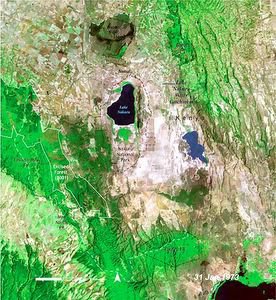
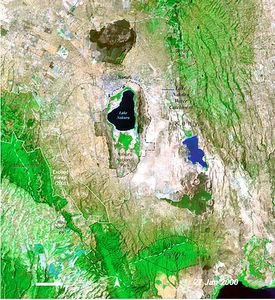
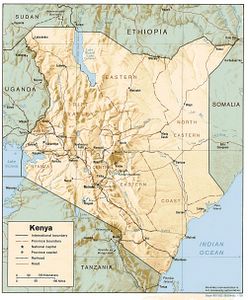
Located in the Eastern Rift Valley in southwest Kenya, Lake Nakuru National Park is the second most visited protected area in Kenya. It hosts the world’s largest concentration of flamingos, as well as many of the animal species that make Kenya a highly valued tourism destination, including lions, leopards, rhinoceros, and water buffalo. Its total surface area measures 188 square kilometers.
The threat of land cover degradation in the catchments of the lake is likely to decrease water quality. These images show the degradation to the land surrounding the lake between 1973 (first image) and 2000 (second image). In 2001, the Government of Kenya announced its intention to harvest 353 square kilometers of forest in the Eastern Mau Forest Reserve (area with white boundary in the 2000 image). As a result, most of the forest cover in the upper catchment of the main rivers that feed Lake Nakuru will disappear.
Lake Songor:
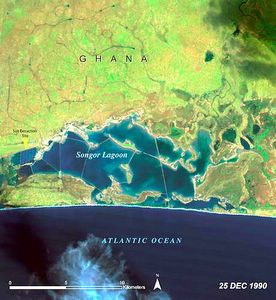
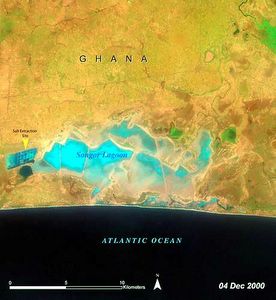
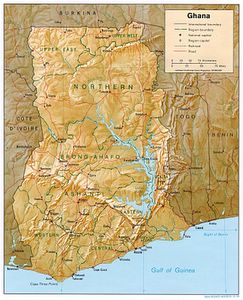
Songor Lagoon is one of the two major lagoon systems associated with the Volta River estuary in Ghana in West Africa. The open water area of the lagoon covers about 11,500 hectares and extends about 20 kilometers along the coast. It is separated from the sea by a narrow sand-dune on which small villages are situated. The site hosts several species of globally threatened turtles.
The satellite images show a radical change in the environment. The 2000 (second image) shows a conspicuous reduction in the lakes area and biodiversity, as compared to the situation in 1990 (first image). Much of the change resulted from salt extraction. The salt extraction site is located on the western part of the lake.
Lake Tonga:
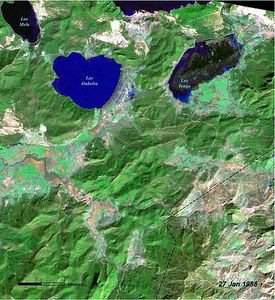
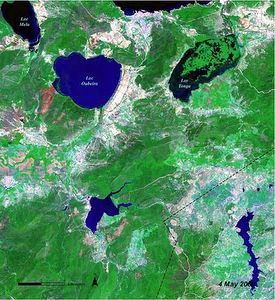
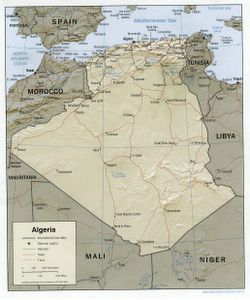
1988 (first image), 2000 (second image). Lake Tonga - at the upper right of the photos - is located east of the town El Kala in the most northeastern part of Algeria. It is one of the lakes in Africa which shows the extreme impacts of human influence and climate change. In 1999 it completely dried up due to uncontrolled withdrawal of water from the lake and damming in the upper stream feeding the body of water. A drought in Algeria from 1998 to 1999 contributed to the evaporation.
Friday, February 24, 2006
Spiegel: Why Is Mt. Kilimanjaro Melting? (Archive), discussion.
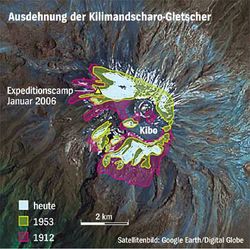

Sunday, February 19, 2006
"To really make an apple pie from scratch, you must first invent the universe." Carl Sagan.
One day a group of scientists got together and decided that they had come so far that they no longer needed God. They picked one of their number to go and tell Him that He was not required any more.
The scientist came up to God and said, "God, we've decided that we no longer need you. We can create living organisms, clone people, and do so many miraculous things - why don't you just go on and get lost."
God listened patiently and when the scientist was done He said, "All right then, how about this, let's have a man making contest." To which the scientist replied, "OK, great! We can handle that."
"And," God added, "we're going to do this just like I did back in the old days with Adam."
The scientist agreed, "Sure, no problem" and bent down to grab a handful of dirt.
God just looked at him and said, "No, no, no. We're doing this from scratch! You go get your own Dirt!"
Friday, February 17, 2006

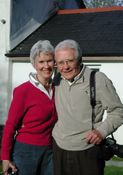 Gaia Theory (overview): Science of the Living Earth
Gaia Theory (overview): Science of the Living EarthJames Ephraim Lovelock, Lynn Margulis, Dian Hitchcock, Ilya Prirogine, Humberto Maturana, Francisco Varela, Andrew Watson, Peter Bunyard
Clinton Richard Dawkins, W. Ford Doolittle
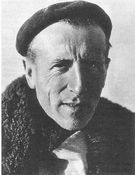 I came at this initially through Pierre Teilhard de Chardin and his book Le Phénomène Humain (1955) / The Phenomenon of Man, or The Human Phenomenon, which I read in English in the 60s. He described a hierarchy in which there exists what he called the 'noosphere', a level above organisms, above the stratosphere; an entity which comprises all of our commonalty as sentient beings.
I came at this initially through Pierre Teilhard de Chardin and his book Le Phénomène Humain (1955) / The Phenomenon of Man, or The Human Phenomenon, which I read in English in the 60s. He described a hierarchy in which there exists what he called the 'noosphere', a level above organisms, above the stratosphere; an entity which comprises all of our commonalty as sentient beings.Fondation Pierre Teilhard de Chardin (French)
Wikipedia: Pierre Teilhard de Chardin
Sitting in Houston last year as hurricane Wilma and then Rita came barrelling in, and me without even a car to get away in; and more recently here in St. John's at the whim of inefficient and bungling infrastructure (when the wind blows, which it does do here, the power goes out, simple as that). Those of you who have seen the cartoon 'Bambi Meets Godzilla' will maybe know how I was feeling, have been feeling. So Gaia was in my mind as I wondered about the Amazonian drought last year (really, this part of it started for me with the murder of Dorothy Stang); and when I was wondering about what Bush might mean with his "addicted to oil" in the State of the Union speech. Then I came upon the first of the essays below by Gwynne Dyer; happened to discuss it with some friends; thought about getting this latest book, The Revenge of Gaia; saw the second essay by Dyer; and here we are.
Gwynne Dyer: The 100,000-Year Fever
Gwynne Dyer: Unsustainable Growth
The Globe this morning was talking about the very much increased rate of melt in Greenland glaciers. I guess the thing to do is start looking at real estate in Greenland and Iceland ... Falkland Islands? Chile? Bolivia? - the highest country in South America may end up with coastline eh?
Lovelock says the answer is nuclear energy - you can see the EFN - Environmentalists For Nuclear Energy site. I can understand his argument, given the timeframe, given the current state of things, what other chance is there? But I still ask, chance for what? Because it has always seemed to me that nuclear energy was just more-of-the-same - enough energy for everyone to squander what they will, ionizing isotopes with 10,000 year half-lives stored away in 50 year containers, and so on.
Already speaking a little Português would make learning Spanish easier than Icelandic I suppose. First I will have a look at this map of Lovelock's that Gwynne Dyer is talking about - have to get well beyond the Tropics it sounds like. I will be too old for breeding maybe, but there is just a chance that I can give someone else close to me (or not) a front row seat.
Down



